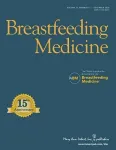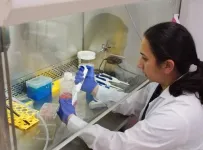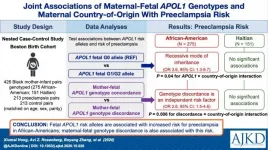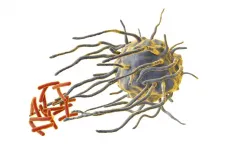(Press-News.org) You've heard of Old Faithful, the Yellowstone National Park geyser that erupts every hour or two, a geological phenomenon on a nearly predictable schedule.
Now, an international group of scientists who study space have discovered an astronomical "Old Faithful" - an eruption of light flashing about once every 114 days on a nearly predictable schedule. The researchers believe it is a tidal disruption event, a phenomenon that happens when a star gets so close to a black hole that the black hole "rips" away pieces of the star, causing the flare.
The team made the discovery using data from NASA and from a network of telescopes operated by The Ohio State University.
Their findings, presented today at the Astronomical Society's annual meeting and accepted for publication in The Astrophysical Journal, are the first clear examples of regular flares erupting from a galaxy's core.
"It's really exciting, because we've seen black holes do a lot of things, but we've never seen them do something like this - cause this regular eruption of light - before," said Patrick Vallely, a co-author of the study and National Science Foundation Graduate Research Fellow at Ohio State. "It's like an extra-galactic Old Faithful."
The flare is coming from the center of a galaxy in our southern skies, about 570 million light years away. When scientists have witnessed tidal disruption events in the past, they have essentially seen the star destroyed.
But in this case, scientists think the star is circling around a supermassive black hole, getting closer, then zooming away again. As the star approaches the black hole each time, the black hole pulls a little bit of the star away, accreting that part into the black hole. That accretion sends out a flare of light about three times the size of Jupiter each time. That flare - and the fact that it happened regularly - gave scientists their first clue that this was no ordinary space phenomenon.
Scientists have named the regular outbursts of light ASASSN-14ko, after the All-Sky Automated Survey for Supernovae (commonly called ASAS-SN), a network of 20 robotic telescopes headquartered at Ohio State. Data from ASAS-SN allowed Anna Payne, lead author of the paper and a NASA Fellow at the University of Hawai'i at Mānoa, to identify that something strange was happening inside that galaxy.
"Knowing the schedule of this extragalactic Old Faithful allows us to coordinate and study it in more detail," Payne said. Payne and others confirmed the finding, and learned more about it, using data from NASA's Neil Gehrels Swift Observatory and Transiting Exoplanet Survey Satellite (commonly called TESS).
The ASAS-SN network first detected the flare on Nov. 14, 2014. Astronomers initially suggested the outburst was a supernova, but a supernova is a one-time event. In early 2020, Payne examined all of ASAS-SN's data on the galaxy and noticed a series of 17 flares spaced 114 days apart. Flares with any kind of regularity had never been seen before.
Payne and her colleagues predicted that the galaxy would flare again on May 17, 2020, so they coordinated joint observations with ground- and space-based facilities, including multiwavelength measurements with Swift. ASASSN-14ko happened right on schedule. The team predicted and observed flares on Sept. 7 and Dec. 26, 2020.
The team also used TESS data for a detailed look at a past flare. TESS observes swaths of the sky, called sectors, for about a month at a time. During the mission's first two years, the cameras collected a full sector image every 30 minutes. These snapshots created a precise timeline of a single flare that began on Nov. 8, 2018, from dormancy to rise, peak, and decline.
"TESS provided a very thorough picture of that particular flare, but because of the way the mission images the sky, it can't observe all of them," Vallely said. "ASAS-SN collects less detail on individual outbursts, but provides a longer baseline, which was crucial in this case. The two surveys complement one another."
Scientists say the black hole that is causing the flares is very large - about 20 times the size of the black hole in the center of our Milky Way.
Chris Kochanek, Ohio Eminent Scholar, astronomy professor at Ohio State and co-lead of the ASAS-SN project, said there is evidence that a second supermassive black hole exists in that galaxy.
"The galaxy that hosts this object is something of a 'trainwreck' consisting of two galaxies in the process of merging into one," he said.
And while astronomers observed the eruptions recently, they actually happened about 600 million years ago. Because the galaxy is so far away, the light took that long to reach us.
"There was life on Earth, but it was all very primitive," said Kris Stanek, a co-author on the paper and university distinguished professor of astronomy at Ohio State.
Astronomers classify galaxies with unusually bright and variable centers as active galaxies. These objects produce much more energy than the combined contribution of all their stars, which can include excesses at visible, ultraviolet and X-ray wavelengths. Astrophysicists think the extra emission comes from near the galaxy's central supermassive black hole, where a swirling disk of gas and dust accumulates and heats up because of gravitational and frictional forces. The black hole slowly consumes the material, which creates low-level, random changes in the disk's emitted light.
Astronomers have been searching for periodic emissions from active galaxies, which might signal theoretically suggested but observationally elusive cosmic phenomena. The 2020 Nobel Prize in Physics was awarded in part to astronomers studying the supermassive black hole in the Milky Way.
"In general, we really want to understand the properties of these black holes and how they grow," Stanek said. Because the eruptions from this black hole happen regularly and predictably, Stanek said, "it gives us a truly unique opportunity to better understand the phenomenon of episodic mass accretion on supermassive black holes. The ability to exactly predict the timing of the next episode allows us to take data that we could not otherwise take, and we are taking such data already."
INFORMATION:
ASAS-SN is supported by Las Cumbres Observatory and funded in part by the Gordon and Betty Moore Foundation, the National Science Foundation, the Mt. Cuba Astronomical Foundation, the Center for Cosmology and AstroParticle Physics at Ohio State, the Chinese Academy of Sciences South American Center for Astronomy and the Villum Fonden in Denmark.
CONTACTS: Patrick Vallely, vallely.7@osu.edu
Chris Kochanek, kochanek.1@osu.edu
Kris Stanek, stanek.32@osu.edu
Written by Laura Arenschield, arenschield.2@osu.edu
Researchers have found a simple way to eliminate almost all sequencing errors produced by a widely used portable DNA sequencer, potentially enabling scientists working outside the lab to study and track microorganisms like the SARS-CoV-2 virus more efficiently.
Using special molecular tags, the team was able to reduce the five-to-15 per cent error rate of Oxford Nanopore Technologies' MinION device to less than 0.005 per cent -- even when sequencing many long stretches of DNA at a time.
"The MinION has revolutionized the field of genomics by freeing DNA sequencing from the confines of large laboratories," says Ryan Ziels, an ...
Scientists have used gene-editing advances to achieve a tenfold increase in the production of super-bug targeting formicamycin antibiotics.
The John Innes Centre researchers used the technology to create a new strain of Streptomyces formicae bacteria which over-produces the medically promising molecules.
Discovered within the last ten years, formicamycins have great potential because, under laboratory conditions, superbugs like MRSA do not become resistant to them.
However, Streptomyces formicae only produce the antibiotics in small quantities. This has made it difficult to scale up ...
ITHACA, NY - Invasive round goby fish have impacted fisheries in the Great Lakes and the Finger Lakes by competing with native species and eating the eggs of some species of game fish.
But the camouflaged bottom dwellers can be difficult to find and collect - especially when they first enter a new body of water and their numbers are low and they might be easier to remove.
In a proof-of-principle study, Cornell researchers describe a new technique in which they analyzed environmental DNA - or eDNA - from water samples in Cayuga Lake to gather nuanced information about the presence of these invasive fish.
The study, "Nuclear eDNA Estimates Population Allele Frequencies and Abundance in Experimental Mesocosms and Field Samples," was ...
In a large population-based family study, family history of kidney disease was strongly associated with increased risk of chronic kidney disease.
In this large population-based family study recently published in the American Journal of Kidney Diseases, researchers investigated the familial aggregation of CKD by comparing the risk of chronic kidney disease (CKD) in individuals with an affected first-degree relative to that in the general population. Participants with an affected first-degree relative were observed to have a threefold higher risk of CKD compared to that in the general population, independent of BMI, hypertension, diabetes, hypercholesterolemia, history of cardiovascular disease (CVD), and smoking status. ...
New Rochelle, NY, January 12, 2021--The Academy of Breastfeeding Medicine (ABM) does not recommend cessation of breastfeeding for individuals who are vaccinated against COVID-19. In a new statement, the ABM suggests that lactating women discuss the risks and benefits of vaccination with their health care provider, within the context of their risk of contracting COVID-19 and of developing severe disease, according to the peer-reviewed journal Breastfeeding Medicine. Click here to read the ABM statement now.
This is a challenging topic because the vaccine trials excluded lactating women. Thus, there are no clinical data regarding the safety ...
The body's immune system is the first line of defense against infections like bacteria, viruses or cancers. Some cancers, however, have developed the art of molecular deception to avoid destruction by the body's immune system. However, a University of Missouri researcher might have found a new way to help the body's immune system get past that deception and destroy the cancer.
"Normally, your body's immune cells are constantly on patrol to identify and destroy foreign entities in the body," said Yves Chabu, an assistant professor in the Division of Biological Sciences. "Normal cells put up a 'don't-eat-me' molecular ...
Acknowledging that COVID-19 may be here to stay, Oregon Health & Science University has laid out a series of steps to prepare patients for elective surgery following their illness.
The evaluation, outlined in a commentary published in the journal Perioperative Medicine, is believed to be the first published protocol laying out a COVID-era path forward in American medicine.
"We think this is groundbreaking," said senior author Avital O'Glasser, M.D., associate professor of medicine (hospital medicine) in the OHSU School of Medicine. "We are hoping other clinics and surgical centers can use this to keep their patients safe."
The work started around Memorial Day, when OHSU clinicians began to see an increasing number of patients ...
Fetal APOL1 kidney risk alleles are associated with increased risk for preeclampsia in African Americans and maternal fetal genotype discordance is also associated with this risk.
Preeclampsia, characterized by increased blood pressure after 20 weeks of pregnancy, as well as other abnormalities (e.g., protein in the urine), is dangerous to mothers and their infants. Previous studies found that individuals with African ancestry may carry APOL1 genetic variants that increase risk for chronic kidney disease. This study published in the American Journal of Kidney Diseases (AJKD) found that fetal high-risk APOL1 genotypes and maternal-fetal APOL1 genotype discordance independently contribute to preeclampsia risk in African-American mothers. This ...
TROY, N.Y. -- An analysis of an exhaustive dataset on cells essential to the mammalian immune system shows that our ability to fight disease may rely more heavily on daily circadian cycles than previously assumed.
Malfunctions in circadian rhythms, the process that keeps our bodies in tune with the day/night cycles, are increasingly associated with diabetes, cancer, Alzheimer's, and many other diseases. An investigation published today in Genome Research shows that the activity of macrophages -- cells within us that seek and destroy intruders like bacteria -- may time daily changes in their responses to pathogens and stress through the circadian control of metabolism.
In this study, ...
Organizations seeking to fill internal roles traditionally have two options: promote from within or hire externally. Internal promotions benefit from being vetted talent who possess firm-specific skills while outside hires harbor external knowledge that can infuse an organization with new energy. Though this dichotomy is often accepted as unavoidable, there is a third option: boomerang employees.
Boomerang employees are those who return to an organization after an amicable absence. Whether the absence was for personal or professional reasons, their return provides unique value to an ...




